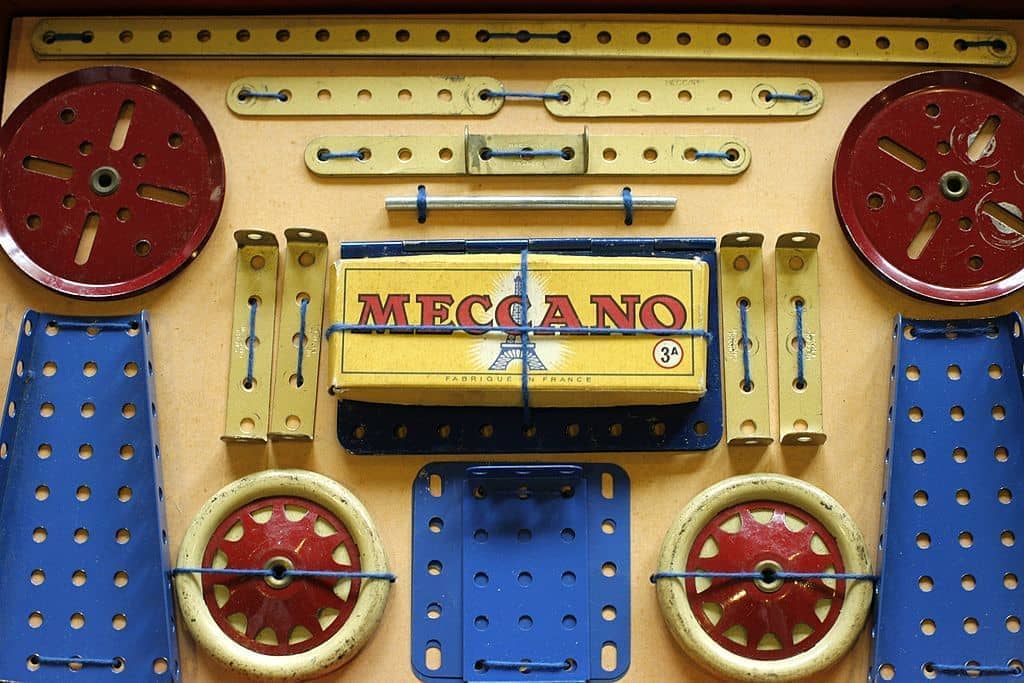Elsewhere in England this weekend, grimly sweating middle-aged men were planning Operation Save Big Dog, Operation Red Meat and Operation Decommission Shopping Trolley. In our house, though, the only game in town for grimly sweating middle-aged men was Operation Racing Car. My son Jonah had received his Covid-postponed eighth birthday present from his cousins and it was – retro! – a Meccano set.
‘Dad, can you help me build it?’ he asked, heteropatriarchonormatively. And of course I gladly forwent my planned afternoon doomscrolling Twitter to see how many new Downing Street parties would be unearthed. Because I had never done Meccano and I thought here was an opportunity to spend some quality bonding time with my son and heir and, besides, an opportunity to show off to him.
Doing Meccano – there were 38 steps in the kit I ‘helped’ with – is basically like assembling Ikea furniture
A larger version of the experience that followed will be familiar to almost everyone. You have been flattered by the apparent ease of assembling a ‘Billy’ bookshelf, so when you’re next wandering through Ikea your eye is caught by something called ‘Ragnarokk’ or ‘Hörsson’ – a magnificent bunk bed unit with soft-close drawers under the lower bunk, integral shelving units, trophy cabinet and fold-out panic room. Fast forward eight hours, and an otherwise well-adjusted adult man is to be found on the floor of his children’s bedroom weeping hot tears of rage, surrounded by a large number of obscure metal widgets and many panels of splintered MDF.
Doing Meccano – there were 38 steps in the kit I ‘helped’ with – is basically like assembling Ikea furniture, except the whole showroom has shrunk to something Mary Norton’s ‘Borrowers’ would feel at home in, so the human assembler is performing his operations under a microscope with a pair of tweezers.
The struggle is real. Here you are, trying to insert a screw less than half a centimetre long through two or three separate thicknesses of plastic and metal, hold it in place, align a nut so small your fat fingers struggle to pick it up from the table with the other end of the screw, and then you’re expected to use one of your other hands, the third one, to engage that nut with a tiny plastic spanner while your fourth hand applies a pixie-sized allen-key to the head of the screw. And then, this finally having been achieved, you perform the whole operation in reverse because you realise you’ve put it on upside down.
Yet, to my mild astonishment, the eight-year-old owner of the set stayed beside me every step of the way. The pallid lunchtime sky grew grimy and then dark in the window. He did not drift off to play on the iPad or demand biscuits. He patiently identified and set out the pieces for the next step: two of this screw, two of that bolt, one four-hold strip, one three-hole metal strip, one of those funny U-shaped jobs… Where he could, he did the job of tightening the bolts once the screw/nut connection was safely secured. He shared my small triumphs and expanded his vocabulary as he witnessed my many setbacks.
And this process – at least once we had staggered, like shivering Munro-baggers cresting the last ridge, to the finish line – was in the end deeply proud-making. We glowed, father and son alike. Here was the unusual experience, these days, of fiddly, slow, patient, frustrating work yielding the reward of eventual satisfaction. I passed our completed racing car with torn and bleeding fingers to my son, in the hopes he would show it to his parents, his grandparents and distant relatives on the family WhatsApp group to secure the astonished admiration I felt sure I deserved. As he trotted off, I looked idly at the box and noticed something. ‘8+’ it said, in small friendly letters.
This caused me to reflect, a little. As someone who at 48+ had struggled for several hours to assemble it, I don’t believe that there’s an eight-year-old anywhere in the country who could have put together that (pretty entry-level) set unassisted. And yet, I can’t imagine that this age advice was put in in bad faith – I suspect, rather, that it’s a relic of a time when eight-year-olds really were capable of making Meccano. I don’t say this to denigrate the youth of today, of course. I have no doubt there’s quite the difficulty curve in Minecraft, and I’ve had my own moments, as a young thing, with the larger sort of Lego set. But this is a different and less forgiving order of pre-adolescent challenge.
Meccano was invented in the very early years of the 20th century and anecdotally, at least, the early versions of it were even harder to use. It is the sort of toy that what Americans like to call the Greatest Generation was raised on. I conclude that the men who fought the Second World War learnt logistics, fine motor skills, unrealistic personal ambition and sheer bloody-mindedness through Meccano. I know now why they won that war – and I have a faint sense of why they might have been in the mood to have it in the first place.







Comments